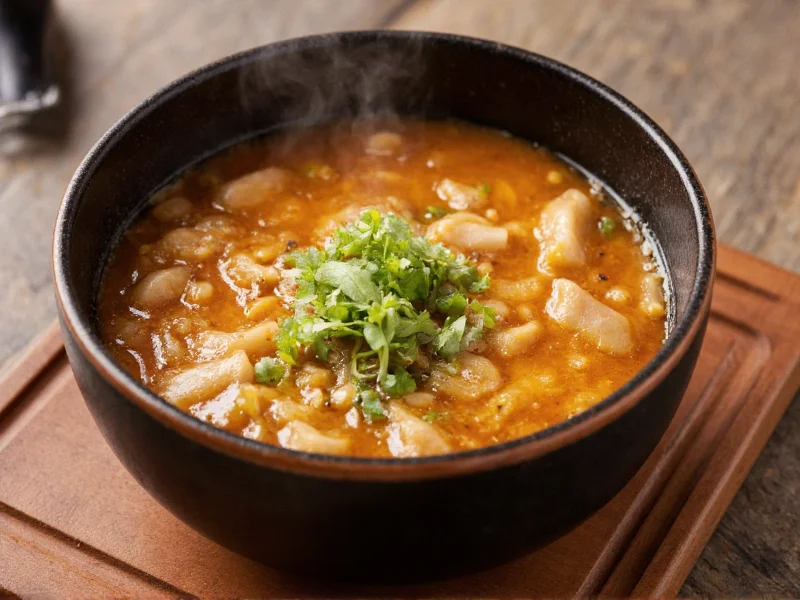The Essential Korean Soup Every Home Cook Should Master
When searching for a genuine soup korean recipe, Kimchi Jjigae stands as Korea's most beloved everyday stew. Unlike broth-based Western soups, this hearty jjigae (stew) features aged kimchi as its flavor foundation, creating complex sour-spicy notes that balance perfectly with pork belly and soft tofu. Korean households maintain kimchi jars specifically for stewing—the older and more fermented, the better the soup's depth.
Cultural Significance of Kimchi Jjigae
In Korean culinary tradition, Kimchi Jjigae represents resourceful cooking. Families historically used over-fermented kimchi (too sour for banchan) to create this nourishing stew, minimizing waste while maximizing flavor. Served bubbling hot in individual stone pots (dolsot), it's commonly enjoyed with steamed rice and banchan (side dishes) during cold months or as hangover relief—a true Korean comfort food staple.
Authentic Ingredients Breakdown
The magic lies in ingredient quality and proper fermentation. Here's what you need for an authentic traditional korean soup recipe:
| Core Ingredients | Why It Matters | Authentic Substitutes |
|---|---|---|
| 3 cups aged kimchi (30+ days) | Provides sour complexity; fresh kimchi lacks depth | Napa cabbage kimchi only |
| 200g pork belly | Traditional fat source; renders flavor | Beef brisket (for non-pork households) |
| 1 block soft tofu | Absorbs broth; adds protein | Firm tofu (less traditional) |
| 1 tbsp gochugaru (Korean chili flakes) | Essential for authentic heat profile | None (critical ingredient) |
Step-by-Step Cooking Instructions
Follow this precise method for the best korean soup recipe that captures authentic flavors:
- Sauté pork: Render 200g pork belly in a stone pot until golden (5 mins). Remove excess fat but keep 1 tbsp for flavor.
- Fry kimchi: Add 3 cups aged kimchi and 1 tbsp gochugaru. Stir-fry 7-10 minutes until kimchi softens and releases juices.
- Build broth: Pour 4 cups anchovy-kelp stock (or water). Simmer 15 minutes to meld flavors.
- Add tofu: Gently place 300g soft tofu cubes into broth. Avoid stirring to prevent breaking.
- Final simmer: Cook 5 more minutes. Season with 1 tsp fish sauce (optional) and sliced green onions.
Avoid These Common Mistakes
Many easy korean soup recipes fail due to:
- Using fresh kimchi - Requires aged kimchi (minimum 2 weeks) for proper sourness
- Over-stirring tofu - Causes disintegration; add last and handle gently
- Skipping pork rendering - Pork fat carries flavor; don't substitute oil
- Adding kimchi juice - Only use solid kimchi pieces; liquid makes soup watery
Serving Authenticity Tips
For true Korean dining experience:
- Serve immediately in preheated dolsot (stone pot) to maintain bubbling temperature
- Accompany with steamed short-grain rice and 3-4 banchan (kimchi, spinach, bean sprouts)
- Dip rice directly into stew—never mix rice into soup (a cultural faux pas)
- Finish with a raw egg stirred into the hot broth at the table
Variations Across Korea
Regional korean soup recipes with kimchi differ significantly:
- Seoul style: Pork-centric with minimal vegetables
- Busan coastal version: Adds squid and clams for seafood depth
- Rustic countryside: Includes potatoes and zucchini for heartiness
- Vegan adaptation: Uses mushroom broth and omit pork (less traditional)
Storage and Reheating Guide
Kimchi Jjigae improves overnight as flavors meld. Store in airtight container:
- Fridge: Keeps 4 days—flavors intensify pleasantly
- Reheating: Warm gently on stove (not microwave) to preserve texture
- Freezing: Not recommended—tofu becomes spongy upon thawing
Frequently Asked Questions
Can I make authentic Korean soup without pork?
Yes, but it won't be traditional. Many Korean households make vegan versions using mushroom broth and omit pork. While acceptable for dietary restrictions, pork fat carries essential flavor compounds that define authentic Kimchi Jjigae. For closest approximation, use 2 tbsp toasted sesame oil to replace rendered fat.
Why does my Korean soup recipe taste too sour?
Overly sour kimchi Jjigae typically results from using excessively aged kimchi (beyond 60 days) or adding kimchi juice. Balance sourness by: 1) Adding 1 tsp sugar during simmering, 2) Including 100g diced potatoes to absorb acidity, or 3) Using younger kimchi (2-3 week fermentation). Never add baking soda—it destroys authentic flavor profile.
What's the difference between Korean soup and stew?
In Korean cuisine, 'guk' (soup) has more broth and is served throughout meals, while 'jjigae' (stew) like Kimchi Jjigae has less liquid, thicker consistency, and is eaten as a main dish with rice. Authentic Korean soup recipes maintain distinct categories—this recipe is technically a jjigae despite being called 'soup' in English.
How do I make Korean soup spicier without losing flavor?
To increase heat authentically: 1) Add gochugaru during kimchi stir-fry (not at end), 2) Include 1-2 fresh Korean chili peppers (cheongyang) while simmering, or 3) Stir in 1 tsp gochujang (fermented chili paste) with broth. Avoid generic chili flakes—Korean gochugaru provides unique sweet-heat profile essential to authentic korean soup recipes.











 浙公网安备
33010002000092号
浙公网安备
33010002000092号 浙B2-20120091-4
浙B2-20120091-4